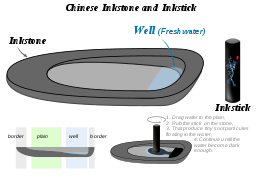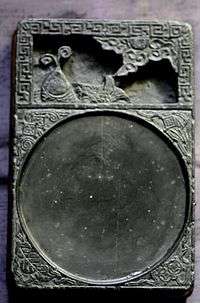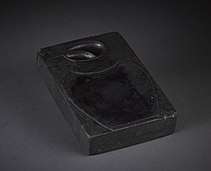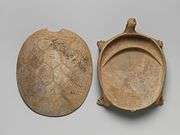Inkstone
An inkstone is a stone mortar for the grinding and containment of ink.
| Inkstone | |||||||
|---|---|---|---|---|---|---|---|
 | |||||||
| Chinese name | |||||||
| Traditional Chinese | 硯臺 | ||||||
| Simplified Chinese | 砚台 | ||||||
| |||||||
| Korean name | |||||||
| Hangul | 벼루 | ||||||
| |||||||
| Japanese name | |||||||
| Kanji | 硯 | ||||||
| Hiragana | すずり | ||||||
| Katakana | スズリ | ||||||
| |||||||
In addition to stone, inkstones are also manufactured from clay, bronze, iron, and porcelain.
The device evolved from a rubbing tool used for rubbing dyes dating around 6000 to 7000 years ago.[1]
Usage
Traditional East Asian ink is solidified into inksticks. Usually, some water is applied onto the inkstone (by means of a dropper to control the amount of water) before the bottom end of the inkstick is placed on the grinding surface and then gradually ground to produce the ink.
More water is gradually added during the grinding process to increase the amount of ink produced, the excess flowing down into the reservoir of the inkstone where it will not evaporate as quickly as on the flat grinding surface, until enough ink has been produced for the purpose in question.
The Chinese grind their ink in a circular motion with the end flat on the surface whilst the Japanese push one edge of the end of the inkstick back and forth.
Water can be stored in a water-holding cavity on the inkstone itself, as was the case for many Song Dynasty (960–1279) inkstones. The water-holding cavity or water reservoir in time became an ink reservoir on later inkstones. Water was usually kept in a ceramic container and sprinkled on the inkstone. The inkstone, together with the ink brush, inkstick and Xuan paper, are the four writing implements traditionally known as the Four Treasures of the Study.
History
The inkstone is Chinese in origin and is used in calligraphy and painting. Extant inkstones date from early antiquity in China. The device evolved from a rubbing tool used for rubbing dyes dating around 6000 to 7000 years ago.[1] The earliest excavated inkstone is dated from the 3rd century BC, and was discovered in a tomb located in modern Yunmeng, Hubei. Usage of the inkstone was popularized during the Han Dynasty.[2] Stimulated by the social economy and culture, the demand for inkstones increased during the Tang Dynasty (618–905) and reached its height in the Song Dynasty (960–1279). Song Dynasty inkstones can be of great size and often display a delicacy of carving. Song Dynasty inkstones can also exhibit a roughness in their finishing. Dragon designs of the period often reveal an almost humorous rendition; the dragons often seem to smile. From the subsequent Yuan Dynasty, in contrast, dragons display a ferocious appearance. The Qianlong Emperor had his own imperial collection of inkstones catalogued into a twenty-four chapter compendium entitled Xiqing yanpu (Hsi-ch'ing yen-p'u). Many of these inkstones are housed in the National Palace Museum collection in Taipei.
Books and scholarship on the various inkstones of China existed chiefly in Japan, where a long bibliography on the subject exists. Inkstones should be appreciated in the context of the traditional scholar's studio culture and the appreciation of furnishings, antiques, paper, seals and all other associated objects. Members of the Chinese literati, such as the Song Dynasty's Ouyang Xiu, contributed greatly to this new culture.
Four Famous Inkstones
For serious calligraphers and painters, a good inkstone is as important as the quality of the ink. An inkstone will affect the quality and texture of the ink that is ground upon it. Four kinds of Chinese inkstones are especially noted in inkstone art history and are popularly known as the "Four Famous Inkstones".
- Duan inkstones (simplified Chinese: 端砚; traditional Chinese: 端硯; pinyin: Duānyàn) are produced in Zhaoqing, Guangdong Province, and got its name from Duan Prefecture that governed the city during the Tang Dynasty.[3] Duan stone is a volcanic tuff, commonly of a purple to a purple-red color. There are various distinctive markings, due to various rock materials imbedded in the stone, that create unique designs and stone eyes (inclusions) which were traditionally valued in China.[3] A green variety of the stone was mined in the Song Dynasty. Duan inkstones are carefully categorized by the mines (k'eng) from which the raw stone was excavated. Particular mines were open only for discrete periods in history. For example, the Mazukeng mine was originally opened in the Qianlong reign (1736-1795), although reopened in modern times.
- She inkstones (simplified Chinese: 歙砚; traditional Chinese: 歙硯; pinyin: Shèyàn) come from She County (Anhui Province) and Wuyuan County (Jiangxi Province). Both counties were under jurisdiction of the ancient She Prefecture of Huizhou during the Tang Dynasty when the She inkstone was first made. This stone is a variety of slate and like Duan stone is categorized by the various mines from which the stone was obtained historically. It has a black color and also displays a variety of gold-like markings.[4] She inkstones were first used during the Tang Dynasty.[4]
- Tao(he) inkstones (simplified Chinese: 洮(河)砚; traditional Chinese: 洮(河)硯; pinyin: Táo(hé)yàn) are made from the stones found at the bottom of the Tao River in Gansu Province.[5] These inkstones were first used during the Song Dynasty and became rapidly desired.[6] It bears distinct markings such as bands of ripples with varying shades.[6] The stone is crystalline and looks like jade. These stones have become increasingly rare and are difficult to find. It can easily be confused with a green Duan stone, but can be distinguished by its crystalline nature.
- Chengni inkstones (simplified Chinese: 澄泥砚; traditional Chinese: 澄泥硯; pinyin: Chéngníyàn) are ceramic-manufactured inkstones. This process began in the Tang Dynasty and is said to have originated in Luoyang, Henan.
Gallery
 She inkstone from Song Dynasty, China (Nantoyōsō Collection, Japan)
She inkstone from Song Dynasty, China (Nantoyōsō Collection, Japan)- Taohe inkstone from Song Dynasty, China, with Ming Dynasty inscription (Nantoyōsō Collection, Japan)
 Inkstone with Jar Pattern, c. 1800-1894 from the Oxford College Archives of Emory University.
Inkstone with Jar Pattern, c. 1800-1894 from the Oxford College Archives of Emory University. Earthenware Inkstone and Cover in the Shape of a Turtle, ca. 6th–7th century from the Metropolitan Museum
Earthenware Inkstone and Cover in the Shape of a Turtle, ca. 6th–7th century from the Metropolitan Museum
Notes
- Tingyou Chen (3 March 2011). Chinese Calligraphy. Cambridge University Press. p. 43. ISBN 978-0-521-18645-2.
- China: Dawn of a Golden Age, 200-750 AD. Metropolitan Museum of Art. 2004. p. 108. ISBN 978-1-58839-126-1.
- Zhang, Wei (2004). The four treasures: inside the scholar's studio. San Francisco: Long River Press. pp. 39–41. ISBN 1-59265-015-5.
- Zhang, Wei (2004). The four treasures: inside the scholar's studio. San Francisco: Long River Press. pp. 48–49. ISBN 1-59265-015-5.
- "Gansu Tao Inkstone". chinaculture.org. Ministry of Culture, P.R.China. Archived from the original on 24 March 2014. Retrieved 3 November 2011.
- Zhang, Wei (2004). The four treasures: inside the scholar's studio. San Francisco: Long River Press. pp. 49–52. ISBN 1-59265-015-5.
References
- T.C.Lai, Treasures of a Chinese Studio, Hong Kong, 1976.
- Kitabatake Sōji and Kitabatake Gotei, Chūgoku kenzai shūsei (A Compendium on Chinese Inkstones), Tokyo, 1980.
- Kitabatake Sōji and Kitabatake Gotei, Suzuri-ishi gaku (An Inkstone Encyclopedia), Tokyo, 1977.
- Yin-ting hsi-ch'ing yen-p'u (An Imperial Catalogue of the Western Brightness Collection of Inkstones), 24 chapters, preface 1778.